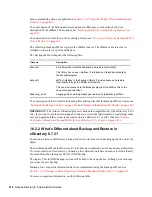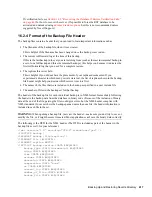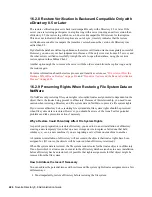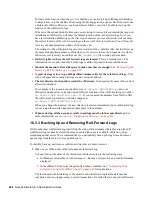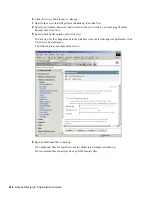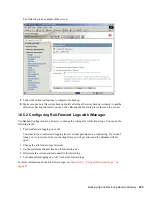
Backing Up and Restoring Novell eDirectory
425
no
vd
ocx
(e
n)
6 Ap
ril 20
07
You can do a new installation and restore eDirectory without taking any special measures, and
after eDirectory is restored, you can plan to do a file system restore for any files you need the
file system rights/trustee assignments to be recovered for.
As part of your backup strategy, you can use trustbar.nlm to back up and restore file system
rights/trustee assignments, or other third-party software that lets you do the same thing. This
way, you can restore trustee assignments to the file system if necessary, after eDirectory is
restored.
You could schedule backups of the file system rights/trustee assignments at intervals similar to
the schedule you use to back up eDirectory and the file system.
NOTE:
You can schedule the backup of file system rights using third-party scheduling
software or
cron.nlm (http://support.novell.com/servlet/tidfinder/2939440)
, available from the
Novell Support Web site.
You can reconfigure your storage system to reduce the probability of failures that require
restoring eDirectory and file system data. For example, by using a RAID system or another
configuration, you can reduce the chances of loss of data if an individual storage device fails. If
you have a redundant sys: volume and suffer a device failure, it's more likely that a new
installation of eDirectory and a file system restore would not be necessary.
If you restore the file system data before eDirectory for some reason, and you lose rights, you
can do the file system restore again after restoring eDirectory.
You can make sure that no volumes except sys: are mounted until eDirectory is restored, such
as in a case where a storage device failure affects the sys: volume but other storage devices on
the server are still functioning.
One way to ensure that volumes will not be mounted is to disconnect the storage devices from
the server before the new installation of NetWare and eDirectory, and then reconnect them after
the eDirectory restore is complete.
After eDirectory is restored, if necessary you could do a file system restore of sys: to recover
rights on the sys: volume.
16.3 Using Roll-Forward Logs
Roll-forward logging is similar to journaling on other database products. The roll-forward logs
(RFLs) are a record of all changes to the database.
The advantage of using roll-forward logging is that the roll-forward logs give you a history of
changes since the last full or incremental backup, so you can restore eDirectory to the state it was in
at the moment before a failure. Without roll-forward logs, you can restore eDirectory only to the
point of the last full or incremental backup.
eDirectory creates a record of transactions in a log file before committing them to the database. By
default, the log file for these records is reused over and over (consuming only a small amount of disk
space), and the history of changes to the eDirectory database is not being saved.
When you turn on continuous roll-forward logging, the history of changes is saved in a set of
consecutive roll-forward log files. Roll-forward logging does not reduce server performance; it
simply saves the log file entries that eDirectory is already creating.
You must turn on roll-forward logging for servers that participate in a replica ring. If you don't,
when you try to restore from your backup files you will get errors and the database will not open.
The restore by default won't open a database that shares replicas with other servers unless it is
Summary of Contents for EDIRECTORY 8.8 SP2
Page 4: ...novdocx en 6 April 2007...
Page 116: ...116 Novell eDirectory 8 8 Administration Guide novdocx en 6 April 2007...
Page 128: ...128 Novell eDirectory 8 8 Administration Guide novdocx en 6 April 2007...
Page 255: ...256 Novell eDirectory 8 8 Administration Guide novdocx en 6 April 2007...
Page 406: ...408 Novell eDirectory 8 8 Administration Guide novdocx en 6 April 2007...
Page 563: ...566 Novell eDirectory 8 8 Administration Guide novdocx en 6 April 2007...
Page 573: ...576 Novell eDirectory 8 8 Administration Guide novdocx en 6 April 2007...
Page 601: ...604 Novell eDirectory 8 8 Administration Guide novdocx en 6 April 2007...




